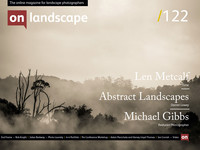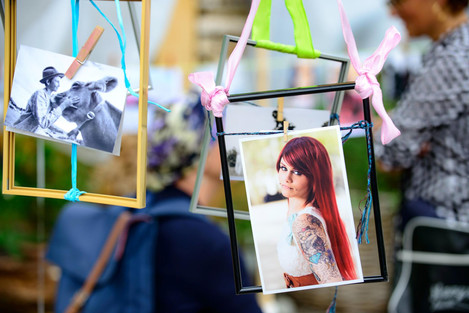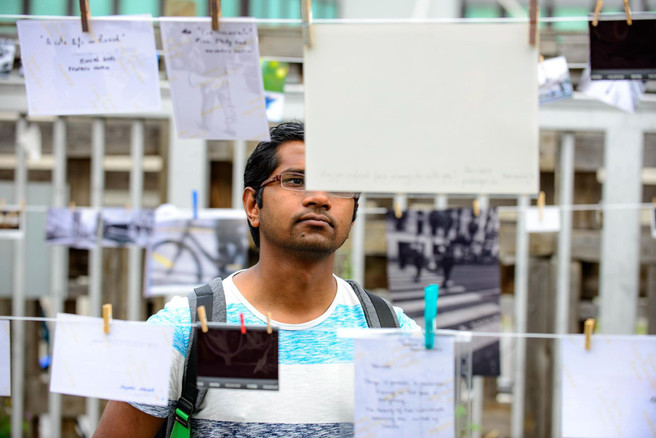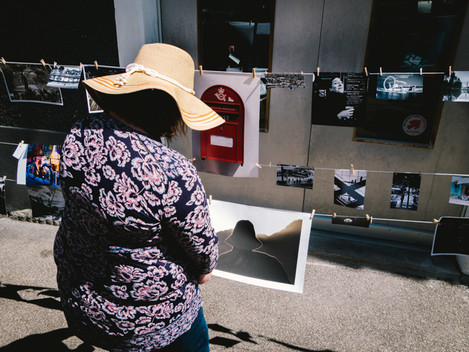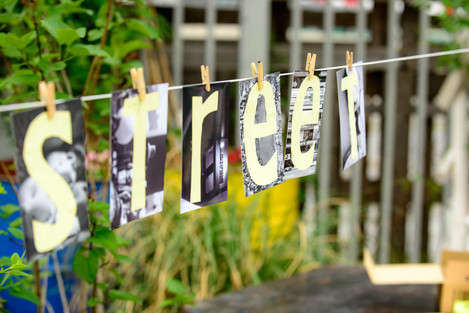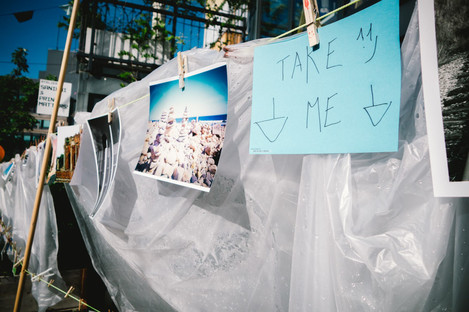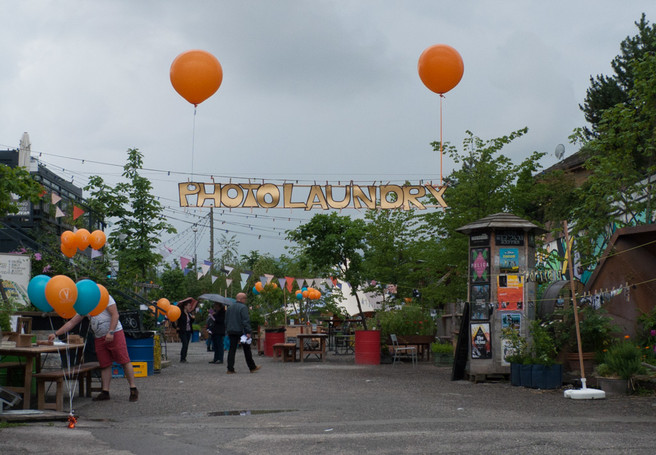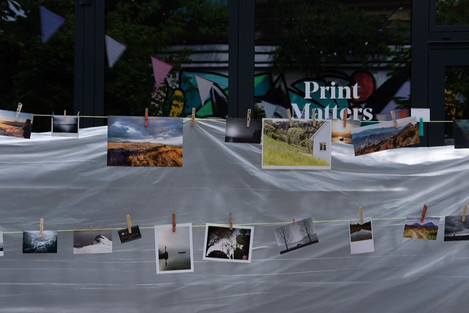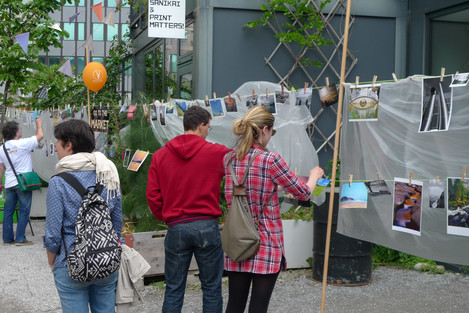Community Driven Pop Up Exhibitions

Julian Barkway
Iam what can best be described as an enthusiastic amateur photographer. I try not to follow fashion or trends and I’m never happier than shooting with my 5x4 camera on good old sheet film. The intimate landscape is what interests me which is, perhaps, surprising given that I have been based in Switzerland for a number of years. My favoured habitat is the bottom of a rocky gorge but I do occasionally emerge to shoot the bigger vista. And I do occasionally shoot digital - but shhh, don’t tell anyone! website
When you look at the history of photography, the contribution of Russia is sadly not writ large. Apart from some fascinating pre-revolutionary work with the tri-colour and autochrome processes and experimentation with photo-montage during the Soviet era, it is fair to say that not much in the way of photographic innovation has historically come from Russia. The reasons for this are many and varied, but nowadays it is a very different country and new ideas from Russia are already making themselves felt in the world of photography. The rise of Lomography, Holga and other ‘toy’ cameras being the most noticeable.
What is Photo Laundry?
‘Sushka’ (to its Russian friends) was the brainchild of Andrei Kezzin, a teacher at the St. Petersburg Academy of Photography. The first event was held in 2011 and since then similar events have been organised in over a hundred Russian cities, as well as in Europe (London, Essen, Murcia), Australia and New Zealand. And, of course, my club’s event in Zurich. Visually resembling the print-drying lines that were strung across traditional photo labs, it’s part community event, part print-exchange and part pop-up exhibition.
The premise is simple: a basic makeshift exhibition space is provided (usually outdoors), and people are invited to come with their own prints to hang on the lines provided.
PICZ & Our Photo Laundry
All of which brings me to the Photo International Club of Zürich (or PICZ), which I joined last year after being impressed by the energy and creativity shown in the club’s inaugural ‘Sushka’.
PICZ is lucky to have a very international membership with a sizeable contingent from Eastern Europe and Russia. One of our members, Natasha Chub-Afanasyeva, originally an English teacher from Moscow but now a photographer and videographer, got to know about the first-ever event in St. Petersburg and thought she would try to bring the concept to Zurich.
What appealed, she explains, was the Photo Laundry’s “accessibility and an easy-going flair - for a starting photographer it can be quite intimidating (and costly) entering a serious exhibition when you feel insecure about yourself”. And so the germ of an idea was born. “I simply wanted to participate in such a project… Well, what can you do if there is nothing like that in a city you live in? Create it yourself, of course!
“I felt such an exhibition could be helpful to bring people together to share and discuss their work without going through a standard pre-selection process - that is what I wanted for myself at least. Still, at that moment there was no way I could do it on my own.” And this is where the club stepped in. As Natasha puts it, “when I came to the member’s meeting of the club for the first time, I told everyone about this street exchange project straight away. A year after that we had the first exhibition in place.”
Despite a hard-to-find location and little pre-publicity, the first event (in 2015) was a success. People were intrigued, the event was well-attended, and many prints were pegged on the lines to be viewed and taken away by their new owners. A second event was mooted and planned, a better venue found (a trendy open-air restaurant with full facilities) and better publicity was organised. The concept quickly evolved from a simple exhibition: professional photographers were brought in to give educational talks, and one member brought his collection of Polaroid cameras to use for taking visitors’ portraits.
A professional band (friends of Natasha’s) provided entertainment - essential as it turned out. On the day, we had almost every sort of weather from sun to downpours and thunderstorms. Luckily there was a marquee where the band did a great job of keeping people in the venue as we sat out the showers.
Natasha continues, “In many senses, we are still trying out so we are in continuous change. Next year we will change the venue - we have not yet found a permanent place for the exhibition”.
Of course, in an outdoor setting you have to be prepared for any weather and on the day we had it all – thunder, rain, sun, wind. Not to mention the usual niggling worries and problems. “Although we knew it was going to rain and prepared for it by covering the lines with clear plastic, it was impossible to avoid all the little pitfalls connected with the weather. When you want to grow [an event], you start to seek ways to improve what has been done. So, there are plenty of small issues to address.
“For example, we noticed that some additional clarification is needed directly at the venue communicating to participants what exactly happens during the event. Although everything was written on the webpage and the event page on Facebook, some people felt lost when they arrived.”
How to organise your own ‘Sushka’
Clearly, the first requirement is a venue. Usually, a Photo Laundry is held in the open, but there is no reason a suitable hall couldn’t be found. It’s great if you can find somewhere with catering and toilet facilities, as we did for our second event, but this isn’t absolutely necessary. What is really essential are some lines on which to hang pictures (on two or three levels to maximise the available space) with some poles or other means of support (obviously!) and a large number of clothes pegs with which to hang the pictures.
For outdoor venues, you’ll also need a lot of plastic sheeting or other weather-protection for the prints. Those are the basics. Over and above these come any number of optional items – some decoration for the venue and its approach so as to give a sense of occasion and, if budget permits, peripheral activities (photo workshops, live music, etc.) will help set the mood and encourage visitors.
Important, too, is some basic education about the concept and the organisation of the lines (a simple notice is fine). We used four categories for organising content: Landscape, Street, Portrait and Abstract but these are not hard and fast. Feel free to create your own! In keeping with the informality of the occasion, club members were on hand to lightly police the prints people were hanging (we had a ‘no nudity’ rule to keep it a family occasion) and to give advice, but generally, people seemed to get the idea pretty quickly. We also had a system of tickets allowing visitors to reserve prints for later collection, mainly aimed at ensuring the lines wouldn’t look too bare if the rate of new additions to prints removed slowed too much. This got quite chaotic with people ignoring the tickets and taking prints anyway or tickets simply falling off. Next year we may have a separate, and more strongly policed, a set of lines just for prints people wish to reserve.
And then there’s publicity. These days, a Facebook presence is almost essential but traditional flyers can help to get the message out. Make sure that your budget has a generous allowance for this aspect. To get an idea, here’s the flyer we designed (English version): www.photolaundry.ch
Finally…
The PL concept is a great way of publicising your club while ‘giving something back’ to the wider community and (particularly for club members who may be disillusioned with competitions where the same people always seem to win, dull talks or the usual humdrum club activities) it’s a great way of reviving club life while attracting new blood. The organisation can be as simple or as complex as you wish to make it and club members can be involved in setting up and decorating the venue, being available on the day to answer questions / give advice or simply helping behind-the-scenes with admin or publicity. It’s a win-win for everybody, people respond to it positively (if our experience is anything to go by) and, most importantly, it’s a lot of fun!
I’ll let Natasha have the last word: “To be honest, I am not sure I can say much to encourage other organisers… It is a free project, volunteers work on sheer enthusiasm … What can be the best encouragement? Only that you find the project useful to yourself personally…. So it is either you want to make it happen - because you feel it can benefit you and the community around, or you don’t….
“It should be said that it is a non-commercial cultural project but [in order to] keep it in line with the original name and the spirit of the very first project, there are a couple of rules to follow: entry should be free for all participants, and there should be no pre-selection of photos.
“Being a part of the Photo Laundry community is a great idea as it helps to create a world brand which is associated with the specific type of the event.
“For us, it is the most encouraging thing was to receive positive feedback from the visitors and to know that people felt great and benefited from the event. We are creating it for people, and it is important to know such an event is needed. This helps us to keep our enthusiasm high!”
Links
Moscow Times article about ‘Sushka’ (in English):
https://themoscowtimes.com/articles/russia-hangs-photo-laundry-out-for-the-world-24380
Photo Laundry in Germany (Essen):
https://www.facebook.com/KunstWaschsalon
Photo Laundry in Spain (Murcia):
https://www.facebook.com/FotoSecado/
Our event in Switzerland (Zurich)
https://www.facebook.com/events/1571221476541715/
http://picz.ch/blog/2016/05/31/chance-know-local-community-importance-print-best-shots/
Photo International Club Zurich
http://picz.ch/about-picz/
Natasha’s website:
www.natasha-chub.com
- A bit of creative flair helps. Copyright: Pascal Cornuez
- Attendance was good on the day. Copyright: Pascal Cornuez
- A visitor looks at the work on display during a sunny interlude. Copyright: Natasha Afanasyeva
- Another of the four categories. Copyright: Pascal Cornuez
- Some people just need a little encouragement. Copyright: Julian Barkway
- Making an event of it. Copyright: Julian Barkway
- The name of a local business makes an important point. Copyright: Julian Barkway
- Visitors check out the images on show. Copyright: Myron Bingham
- A couple pose for a Polaroid portrait. Copyright: Julian Barkway
- Helping out one of the younger visitors. Copyright: Pascal Cornuez
- A glimpse ‘behind the scenes’. Copyright: Julian Barkway
- Putting the rain protection in place. copyright: Julian Barkway
- The lines for the ‘Abstract’ category. Copyright: Julian Barkway
- Some images from the ‘Landscape’ category. Copyright: Julian Barkway

